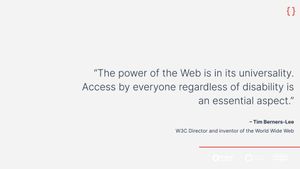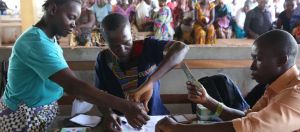CALP Network accessibility and UX audits
In the summer of 2023, the CALP Network commissioned us to deliver an accessibility and usability audit of their digital communication channels.
We worked with them to produce a roadmap to improve and develop their accessibility practices over the long term, including training and capacity building for their teams.
We were excited by the project because it, unusually, centred on accessibility and usability - two distinct but overlapping disciplines.
Our team delivering the project was:
- Richard, Project Lead and UX researcher
- Rae, UX researcher
- Maria, Accessibility lead
The work we did helped kickstart CALP's accessibility journey. We were impressed with how the organisation embraced this and were delighted to give the team the language, skills and confidence to take the work forward.
They now have a roadmap and in-house training to ensure accessibility is a central aspect of their work.
Who are the CALP Network?
The CALP Network is a global network of more than 90 organisations engaged in the critical areas of policy, practice and research in humanitarian cash and voucher assistance (CVA) and financial assistance.
The problem CALP wanted to solve
This project was about helping CALP embed accessibility and usability into its content strategy. It would underpin their approach to deciding what content to create, how best to create it, and how best to evaluate it regularly.
The project was of critical importance to CALP for three reasons:
- to improve outcomes for people affected by crises
- to comply with funding requirements
- to meet legal obligations
There were needs around Section 508 compliance. This is US legislation to ensure that public sector bodies within the United States are not discriminatory to those with any kind of disability.
Our approach
Our approach was divided into five parts (discovery, auditing, reporting, road-mapping, and training).
Each had a focus on enabling lasting change within the organisation.
Discovery phase
Scene-setting and awareness-raising
We started with a whole-team training session to kick-start the project and raise awareness throughout the organisation.
This covered the global context of disability and impairment and their impact on digital accessibility.
We looked at the intersection of multiple factors, such as poverty, health, digital literacy, and gender. We tailored the content to the context of CALP’s work in global humanitarian aid as much as possible.
We used first-person accounts of accessibility barriers and conducted a live demonstration of how people with different disabilities might experience the site.
Theory of Change
To ensure that we had a shared understanding of the aims and outcomes of the project, we undertook a theory of change workshop with the key stakeholders. Using Miro, we formulated a mission statement and timeline with the CALP team in the session.
The mission statement:
“CALP understands what good accessibility and usability is, how accessible/usable our current practices are (especially digital), what we would like to do in the next two years, and a plan for getting there.”



The audits
We conducted accessibility and usability audits of the CALP website and other digital channels, including their YouTube channel, social media accounts, PDFs and online events.
Accessibility audit and testing
We initially carried out our standard desk-based accessibility audit on the website and some key digital channels. The audit includes automated and manual testing using a variety of assistive technologies. This gave us an excellent basis to understand which areas would benefit from live testing with people with disabilities/impairments.
We contacted the Digital Accessibility Centre (DAC), which employs a team of accessibility testers, many of whom have disabilities and use assistive technologies in their daily lives. We spent four two-hour sessions using the website and describing their experience. Their observations and recommendations fed into the overall findings.
All the accessibility findings were written up into comprehensive reports for the different teams involved. This included a detailed report for CALP’s web developers, with enough information to understand, prioritise, replicate and fix each issue.
“Working with DAC was really insightful. Getting first-hand feedback from people with disabilities was very powerful. We learned so much; while our findings were confirmed, we also discovered much more. I couldn't recommend this service enough...” Maria Young, Accessibility Lead, Agile Collective
Usability audit and testing
To begin with, we worked with CALP to identify user needs and then tested the site and other channels against those needs.
We used a heuristic evaluation method to identify usability issues in the user interface design. This is a series of tests against a set of standardised criteria.
In addition, we used personas and user stories to test them against specific usability requirements.
The Report
Our extensive report provided a high-level overview of the website's state based on both of our audits, with recommendations for improvements and fixes in terms of UX and accessibility.
The report aimed to be educational and informative and to explain why an issue caused barriers. This greater understanding will have lasting benefits beyond the short-term fixes we outlined for CALPs developers.
Road mapping
In a collaborative road-mapping session, we worked with the CALP team to prioritise work into achievable and logical streams. The aim was to ensure the right people were equipped and accountable for the work, to take the work forward without us.
This focused on three areas:
- Understanding who is involved and how the work will happen
- What budget is available
- What other support is needed and available
Training
We trained approximately 35 CALP team members in digital communication production in 3 training sessions.
As mentioned above, we ran an introduction to accessibility and usability session, with some live demo’ing of the site as experienced by an individual with limited motor control and blurred vision. This is a powerful tool to help people understand the issues and have greater empathy for the end user.
We had a dedicated session with the communications team, which works across social media, websites, and events. Based on our audits, we gave them feedback on how they could improve content creation. We covered the fundamentals of good content creation and then looked at specifics across the different platforms.
The final training was delivered to the whole CALP team. In this session, we reviewed the findings from all the research. We answered questions about how our recommendations might affect their work and gave them practical tips and tricks to use in their roles.
What we learnt
Here are our three main takeaways from the work:
Taking a combined approach to accessibility and UX has been a real eye-opener for us. By situating accessibility within the broader context of usability, we got much richer results and the suggested site improvements will potentially have a much more positive impact on users.
For the audits, we added layer of testing using a range of agreed-upon standards, which supplemented our usual, more subjective testing and helped create a more systematic approach to the work. In addition, we applied the usability heuristics process. This brought more rigour to the process and helped provide more precise recommendations to CALP. We’ll continue to use and refine this approach with all future clients.
Presenting combined accessibility and usability results in one place became a powerful tool for the client. They used this as the basis of a roadmap, and we worked with them to help prioritise changes. This results document helped them understand the necessary steps rather than overwhelming the clients. We could also break down elements into smaller steps so no problems felt insurmountable.
The Accessibility Journey
Our work helped kickstart CALP’s accessibility journey, and we were impressed with the organisation's embrace of accessibility.
We gave the team all the tools they needed to continue this work. They now have the roadmap and the in-house training to ensure it runs through all aspects of their work.
The project has genuinely changed how we deliver this service, and we've since integrated it into a number of new projects.
When we approached Agile Collective with the vision of crafting a Usability and Accessibility Roadmap for CALP Network, we knew we needed a partner with expertise in Accessibility and User Experience. They were the perfect fit for the project, seamlessly combining their proficiency in these domains.
Our collaboration with Maria, Richard, and Rae from Agile was an absolute pleasure. They not only listened attentively but also delved deep into our organization's intricacies, conducting meticulous research and engaging in insightful conversations. Their project management and execution were outstanding, consistently placing the user's needs at the forefront and incorporating various empathy methods, which yielded revealing results and valuable insights. For CALP, this journey began with a limited understanding of accessibility, but Agile didn't just provide training; they transformed the entire process into an educational experience. The final result, our Usability and Accessibility Roadmap, now serves as a clear way to organize our plans for becoming fully inclusive step by step, making the process less daunting. This project has highlighted that, often, it's the lack of awareness and basic knowledge that hinders accessibility. While implementing these changes may pose challenges, the pursuit of accessibility is a valuable ongoing effort in itself. The reflection and action around inclusivity and accessibility are not only ethical imperatives but are also opening doors to new opportunities, innovation, and advancements in our digital strategy at CALP.
